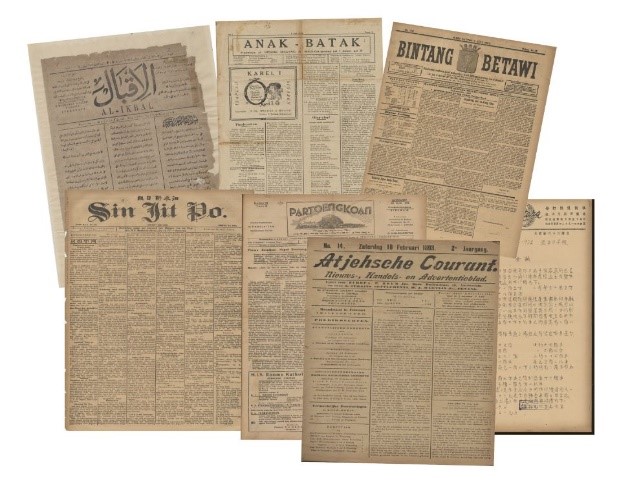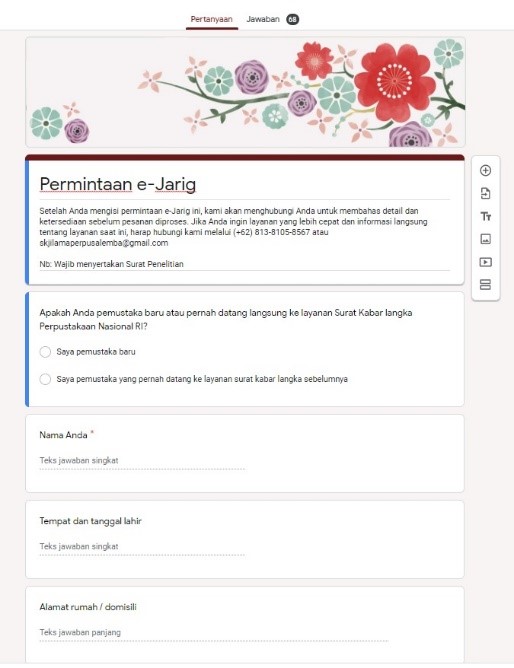“E-JARIG” Innovation of Online Search Demand Services: Collection of Rare Newspapers Collected by the National Library of the Republic of Indonesia in the Pandemic Era
Atikah Haroen
Librarian of the Rare Newspapers Collection Department, The National Library of Indonesia
E-mail : [email protected]
INTRODUCTION
The impact of the pandemic has forced libraries to start shifting from physical to digital services in whole or in part. This makes the role of librarians more challenging and also offers a number of new opportunities. The role of the librarian becomes more important by carrying out various innovations and creativity in providing services. Librarians participate in supporting the lifelong learning process for the community, providing motivation and correct and useful information. Some things that can be done to support the community remotely include communicating with clients through social media via telephone, WhatsApp, and email to keep in touch and to share knowledge with the public.
The National Library of Indonesia till now, still keeps a collection of newspapers from the past, namely relics from the collection of the Bataviaasch Genootschap van Kunten en Weetenschappen. The rarest newspaper collection is the Bataviasche Koloniale Courant, which was published in 1811 until the newspaper collection was bound in 2016. The rare bound newspaper collection is a collection of newspapers that have passed a certain period and are collected and bound in chronological order, either monthly, semester or year later bound. This binding increases the durability of the collection, and makes the collection easier to use. This daily news is a primary source that can be used as a reference for scientific research or a means of historical evidence. The collection of bound newspapers consists of various regional and foreign languages. These include Javanese, Madurese, Sundanese, Batak, Malay, Bugis, Dayak as well as Dutch, English, German, French, Spanish, Arabic, Chinese, and Japanese. This is the reason why the National Library of Indonesia tries to preserve and serve it to its users—mostly students and researchers, as well as the general public.

The interest of the public, especially students and researchers both in Indonesia and abroad, in conducting data searches/searches for rare newspaper collections is very high because:
- Not all the collections of old rare newspapers in National Library have been digitized;
- There is already a collection of rare newspapers in the form of microfilm, but it is hampered by the large number of microfilm collections that are no longer accessible due to damage and most of the readers, especially historians, prefer to read the physical copy;
- Difficulties searching information in rare newspaper collections include the physical format, content, and language
- Not all information is found in books (monographs) and alternative choices as research sources include collections of rare newspapers which are considered a primary source;
- The National Library as a library that has the most complete collection of rare newspapers for Indonesian content (Indonesiana) and its users come from various regions throughout Indonesia and even researchers from abroad.
Before the pandemic, this rare newspaper collection service received quite a number of visits, mostly from students doing final assignments, academic researchers, journalists for flashback reports, and for supporting evidence in court cases. During the pandemic, there was an increase in requests for information retrieval from the public through social media (WA, Email). For this reason, the Bind Rare Newspaper Collection service group created a method to independently to record and document incoming search requests which are given the term “E-JARIG”. This E-jarig innovation is manual search assistance, but the users must first fill out the google search request form. Once they enter the rare newspaper service data, a search by the rare newspaper collection librarian team begins. The search is done by physically opening the pages of rare newspapers, which are given the term “google-finger” this translated to the service name “e-jarig”.
E-FINGER (MANUAL GOOGLE) SERVICE
The following fields are displayed in the E-Jarig form. The user’s personal data consisting of: name, place of birth, date of birth, residential address, telephone/mobile number, email, member number for the National Library of Indonesia, education/job. Then the search query field which consists of:
– topic or subject you are searching
– the required periodicity of newspapers,
– name of newspaper and edition
– research period
– questions and comments
– supporting file sample data requested
– research letter in

CONCLUSION
In the pandemic era, rare newspaper librarians are transformed into subject specialists to be able to transfer knowledge and information requested by users.
The professionalism of librarians transferring this knowledge is important. Using information technology, the process involves an information transliteration process that is able to overcome the limitations of space and time. Science requires and produces information. And this has been proven by librarians from the collection of rare newspapers bound by the National Library of Indonesia. The pandemic has presented a challenge to find new innovations whose ultimate goal is to continue to provide information services to users in an excellent and professional manner.
REFERENCES
- Muhammad Rafiq etc. 2021. University libraries response to Covid-19 pandemic: a developing country perspective. The Journal of Academic Librarianship 47 (2021) 102280.
- Ufuoma D. Onobrakpor. 2019, Information transfer in Libraries and Information Centers: role of Communication. Information Impact: Journal of Information and Knowledge Management, Vol. 10 (2) Dec.
- Hwa-Wi Lee. 2005. Knowledge Management and the Role of Libraries. The 3rd China-US Library Conference
- Ugocha, Oliver C. et.all. 2018. Knowledge sharing among librarians: a literature review. International Journal of Applied Technologies in Library and Information Management 4 (1) 08-78-89